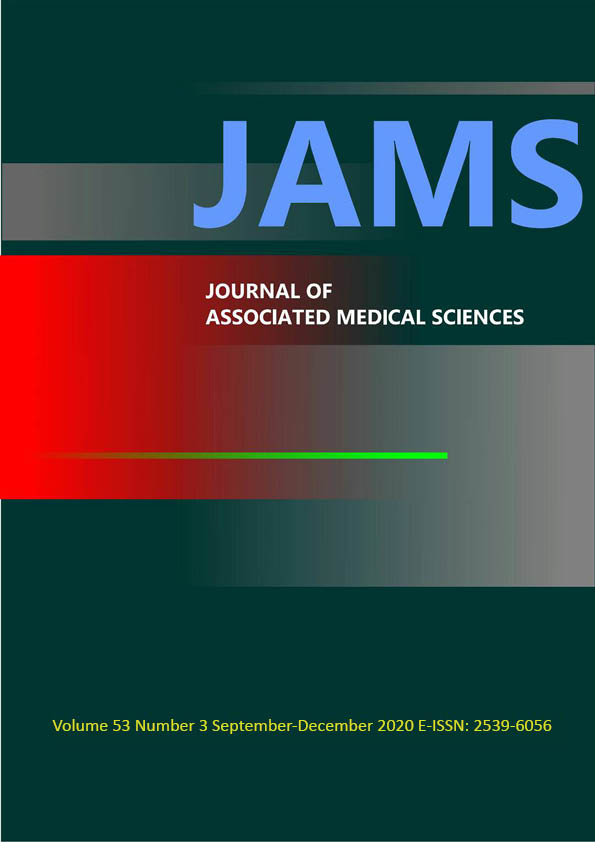The radioprotective potential of Centotheca lappacea (L) desv. extract in human endothelial cell
Main Article Content
Abstract
Background: Radiation-induced vascular injury in normal tissue is a common adverse effect of radiation therapy. Radioprotectors can reduce the adverse effects of radiation-induced vascular injury. However, therapeutic applications of current radioprotectors are limited due to toxicity. Natural compounds derived from medicinal plants are less toxic and favorable for developing of radioprotectors. Centotheca lappacea has been long-term used for medicinal purposes and contains a variety of biological active compounds. Thus, the ethanolic extract from Centotheca lappacea may possibly have the potential to act as radioprotector.
Objectives: To determine radioprotective property of the ethanolic extract from Centotheca lappacea in human endothelial cell (EA.hy 926).
Materials and methods: The effect of the ethanolic extract from Centotheca lappacea on cell viability was assessed by MTT assay. Cell cycle distribution was determined by flow cytometry. Nuclei morphology was determined by fluorescence microscopy. The levels of Akt and phospho-Akt were determined by Western blot analysis.
Results: Pretreatment of cells with 0.2 μg/ml Centotheca lappacea extract for 3 hrs prior to irradiation demonstrated a radioprotective effect on EA.hy926 cells by significantly increasing cell viability and decreasing abnormal nuclei formation.Treatment of the cells with the extract in combination with radiation clearly increased the level of Akt phosphorylation. The extract is not toxic and does not interfere with cell cycle progression of EA.hy926 cells.
Conclusion: The ethanolic extract from Centotheca lappacea possesses radioprotective activity. No toxic impact and no impact on cell cycle progression in EA.hy926 cells were observed. The results indicate that Centotheca lappacea extract is an ideal resource of radioprotector for protecting radiation-induced damage to human endothelial cells.
Article Details

This work is licensed under a Creative Commons Attribution-NonCommercial-NoDerivatives 4.0 International License.
Personal views expressed by the contributors in their articles are not necessarily those of the Journal of Associated Medical Sciences, Faculty of Associated Medical Sciences, Chiang Mai University.
References
. Chen HHW, Kuo MT. Improving radiotherapy in cancer treatment: Promises and challenges. Oncotarget. 2017; 8(37): 62742-58.
. Orth M, Lauber K, Niyazi M, Friedl AA, Li M, Maihofer C, et al. Current concepts in clinical radiation oncology. Radiation and environmental biophysics. 2014; 53(1): 1-29.
. DeZorzi C. Radiation-Induced Coronary Artery Disease and Its Treatment: A Quick Review of Current Evidence. Cardiology Research and Practice. 2018; 2018: 8367268.
. Simonetto C, Eidemuller M, Gaasch A, Pazos M, Schonecker S, Reitz D, et al. Does deep inspiration breath-hold prolong life? Individual risk estimates of ischaemic heart disease after breast cancer radiotherapy. Radiotherapy and oncology: journal of the European Society for Therapeutic Radiology and Oncology. 2019; 131: 202-7.
. Venkatesulu BP, Mahadevan LS, Aliru ML, Yang X, Bodd MH, Singh PK, et al. Radiation-Induced Endothelial Vascular Injury: A Review of Possible Mechanisms. JACC Basic to translational science. 2018; 3(4): 563-72.
. Cuomo JR, Javaheri SP, Sharma GK, Kapoor D, Berman AE, Weintraub NL. How to prevent and manage radiation-induced coronary artery disease. Heart. 2018; 104(20): 1647-53.
. Kamran MZ, Ranjan A, Kaur N, Sur S, Tandon V. Radioprotective Agents: Strategies and Translational Advances. Medicinal research reviews. 2016; 36(3): 461-93.
. Mun GI, Kim S, Choi E, Kim CS, Lee YS. Pharmacology of natural radioprotectors. Archives of pharmacal research. 2018; 41(11): 1033-50.
. G CJ. Radioprotective Potential of Plants and Herbs against the Effects of Ionizing Radiation. Journal of clinical biochemistry and nutrition. 2007; 40(2): 74-81.
. Norsaengsri M, Chantaranothai P. The tribe Centotheceae (Poaceae) in Thailand. Thai For Bull (Bot.).2008;36:52-60.
. McClatchey W. The ethnopharmacopoeia of Rotuma. JEthnopharmacol. 1996; 50: 147-56.
. Pitiporn S. Record of Thailand 7: herbal treatment forwoman. Bangkok: Pauramutha Karn Pim; 2014; p. 134-6. (in Thai)
. Thavatchai Kamoltham T, Rungsimakan S, Supan K, Rodsienglump P. Chemical Constituents of Centotheca lappacea (L.) Desv. Aerial Parts. Journal of Thai Traditional Alternative Medicine. 2017; 15(1):14-29.
. Kamoltham T, Manosroi J, Chankhampan C, Manosroi W, Manosroi A, In vitro Anti-aging Activities of Centotheca lappacea (L) desv. (Ya Repair) Extract. Chiang Mai J. Sci. 2018; 45(2) : 846-57.
. Lodovici M, Caldini S, Morbidelli L, Akpan V, Ziche M, Dolara P. Protective effect of 4-coumaric acid from UVB ray damage in the rabbit eye. Toxicology. 2009; 255(1-2): 1-5.
. Hematulin A, Sagan D, Eckardt-Schupp F, Moertl S. NBS1 is required for IGF-1 induced cellular proliferation through the Ras/Raf/MEK/ERK cascade. Cellular signalling. 2008; 20(12): 2276-85.
. Sahlberg SH, Gustafsson AS, Pendekanti PN, Glimelius B, Stenerlow B. The influence of AKT isoforms on radiation sensitivity and DNA repair in colon cancer cell lines. Tumour biology: the journal of the International Society for Oncodevelopmental Biology and Medicine. 2014; 35(4): 3525-34.
. Toulany M, Rodemann HP. Phosphatidylinositol 3-kinase/Akt signaling as a key mediator of tumor cell responsiveness to radiation. Seminars in cancer biology. 2015; 35: 180-90.
. Demiral AN, Yerebakan O, Simsir V, Alpsoy E. Amifostine-induced toxic epidermal necrolysis during radiotherapy: a case report. Japanese journal of clinical oncology. 2002; 32(11): 477-9.
. Pawlik TM, Keyomarsi K. Role of cell cycle in mediating sensitivity to radiotherapy. International journal of radiation oncology, biology, physics. 2004; 59(4): 928-42.
. Hein A, Ouellette M, Yan Y. Radiation-induced signaling pathways that promote cancer cell survival (Review). Int J Oncol. 2014; 4554): 1813–9.
. Zingg D, Riesterer O, Fabbro D, Glanzmann C, Bodis S, Pruschy M. Differential activation of the phosphatidylinositol 3'-kinase/Akt survival pathway by ionizing radiation in tumor and primary endothelial cells. Cancer Res. 2004; 64(15): 5398-406.
. Li H, Kim J, Waldman T. Radiation-induced Akt activation modulates radioresistance in human glioblastoma cells. Radiat Oncol. 2009; 4(43): 1-10.


